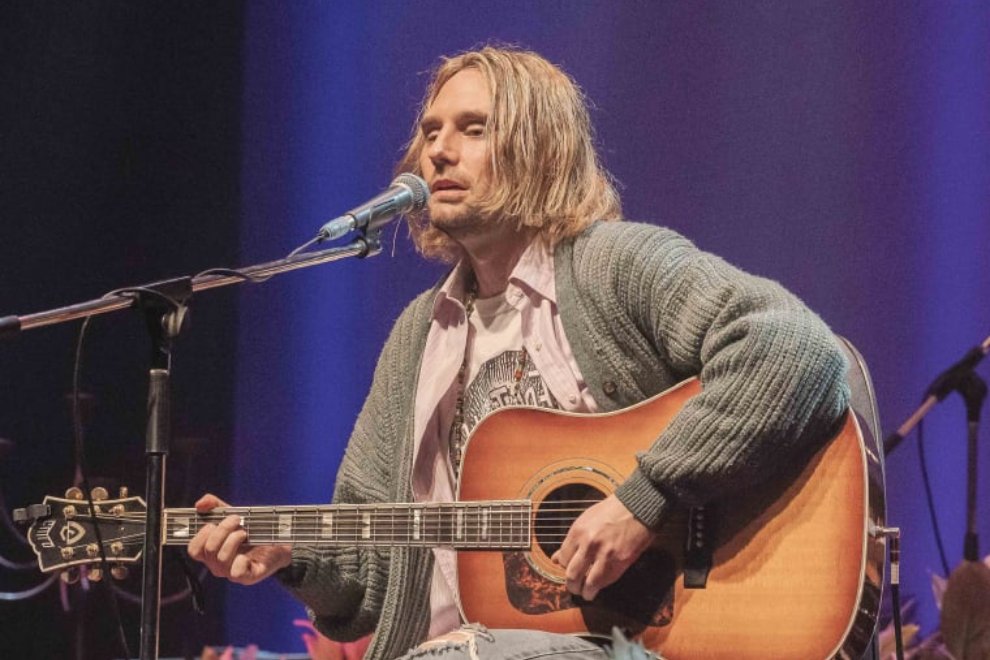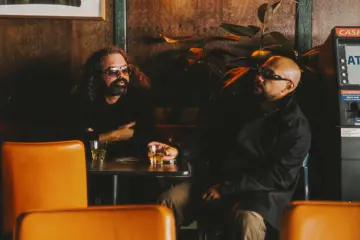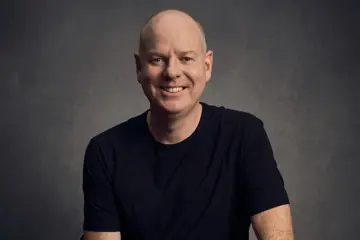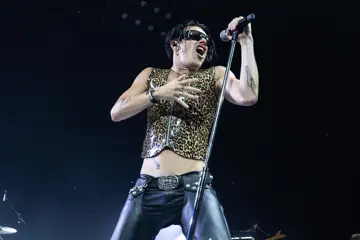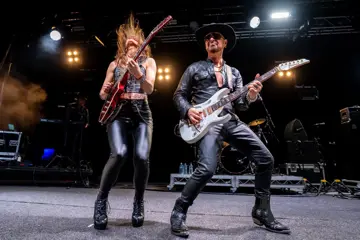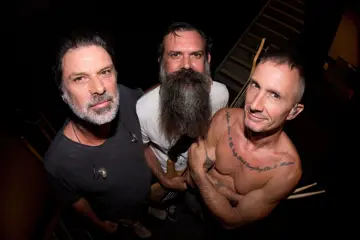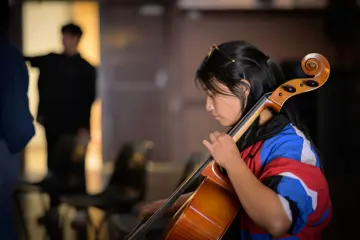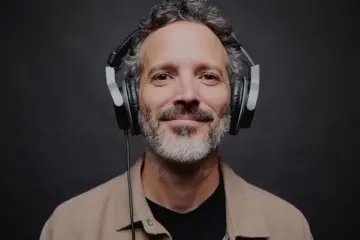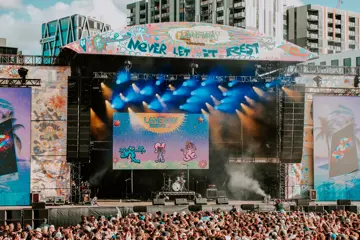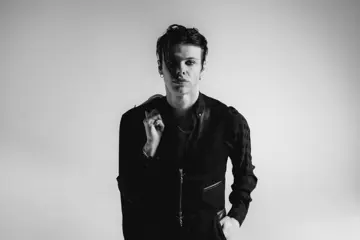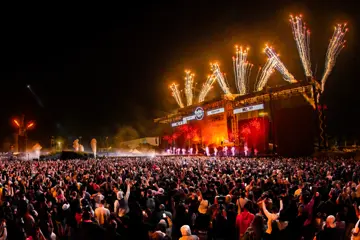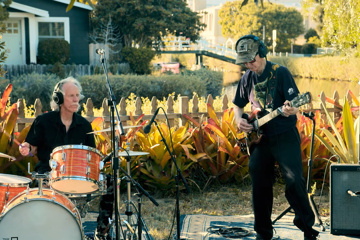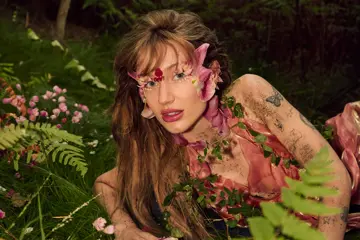It was on the evening of November 18, 1993 that Nirvana made history with their career-defining MTV Unplugged session – the live performance often cited as Kurt Cobain’s all-time greatest, and delivering one of the highest-selling, most critically acclaimed live albums in history.
You’d be hard-pressed to find a rock fan who wouldn’t kill to know what it felt like to be in that room, sharing a truly one-of-a-kind atmosphere with Cobain and co. at Sony Music Studios in Hell's Kitchen, New York. ARIA-winning artist and actor Justin Burford (known best for his leading role in Rock Of Ages, or as the frontman of End Of Fashion) is one of those fans, and after years of dreaming, scheming, rehearsing and fine-tuning, he’s now able to offer his fellow Nirvana die-hards a chance to live their dream.
Come As You Are is the tribute show to end all tribute shows – an authentic, note-for-note recreation of Nirvana’s legendary MTV Unplugged performance, with a whole bonus set of their classic songs recreated in the same vein. Later this month, Burford and his band will it to the Riverside Theatre in Parramatta, with intimate shows slated for Friday July 26 and Saturday 27. Limited tickets for both are on sale now – head here to find them.
Ahead of the shows, we sat down with Burford to learn more about the story behind this jaw-dropping tribute.
Do you remember the first time you personally watched Nirvana’s original MTV Unplugged session? What was going through your mind at that time?
Of course I do! Vividly. First of all though, a fun fact: MTV aired the episode in the US on December 16, 1993, which was my 15th birthday! Like every other Australian though, I had to wait to see it. The album came out in November 1994 and I bought it immediately, but it was a while still after that – I can’t remember exactly how long now, but the ABC aired it as a Rage Special Event. It must have been on a school night because I wasn’t allowed to stay up and watch it, but I taped it and raced home from school the next day to see it.
Don't miss a beat with our FREE daily newsletter
It was introduced by triple j legends Helen Razer and Mikey Robbins, and Helen went on to say she was actually meant to interview both Kurt and Courtney only a week or so after Kurt was found dead in his Seattle home. Mikey said something like, “Some people will do anything to avoid meeting you, Helen,” which struck me at the time as being pretty dark and insensitive – but they were different times then. I doubt he’d get away with saying that on-air today.
By the time it was broadcast here, I’d become very, very familiar with the album. I was absolutely mesmerised by the performance. Kurt almost glowed. You could see how uncomfortable he felt through the first few songs, but he slowly opened up, little by little as the show went on. Back then, pre-Internet, you couldn’t readily see rock and pop stars – we only ever got video clips or the occasional interview. Seeing Kurt in this way completely humanised him. It made him even more relatable, but in a way that felt unearthly and etherial.
His charisma was undeniable, effortless. But he also came across a little goofy, which I loved. He seemed less like a rockstar and more like someone I’d be friends with. I think a lot of fans felt that way, watching that performance. I feel like the generations that have followed still feel that way. It’s truly timeless.
This whole concept is so exciting and fascinating to me – that Unplugged session is iconic, and being able to relive it like this is going to be such an incredible moment. Where did the idea come from to recreate it for the stage?
The idea goes back to about 2012. I’d just wrapped up doing the lead role in the Australian production of the Broadway show Rock Of Ages. We were closing at QPAC in Brisbane and Roger Waters’ show Looking Through A Glass Onion, about John Lennon, was set to come into the theatre after us. At the closing party, I made an offhand comment to one of the producers about how someone should do a show like that for Kurt Cobain.
A few months later, I got a call saying, “We thought about what you said about the Kurt Cobain show and we agree. We’ve booked you at the Adelaide Cabaret Festival.” So I had to write a show! I ended up calling the show KURT, with the concept being that I’d use journal entries and interview excerpts, etcetera – as well as his music, of course – to tell his story in his own words. It got really well received, so we did it again at Haye’s Theatre in Sydney.
Fast forward a few years and I’d started working with Perth Symphony Orchestra as a vocalist. I remember floating the idea of reimagining Nirvana’s music with an orchestra and thought the Unplugged show lent itself to that idea perfectly, playing that setlist in it’s entirety but with a full symphony orchestra in place of a rock band.
It took a year or two to convince them it would work, but eventually we did it. We sold out His Majesty’s Theatre here in Perth, with another sold-out encore performance a year later. We were set to take it nationally but COVID hit and it kind of fizzed out the momentum.
As a fan though, I kept thinking how cool it would be to give people a sense of what it might have been like to have been at that TV studio in New York in 1993. Dress the stage up in candles and lilies. Play through the whole set, just like they did. And that was it. I got to work making it happen. Then I got the idea of for a sort of “what if?” fantasy – how other songs may have sounded if Nirvana decided to play them at the original taping – which became the concept for the second set. That’s the & Beyond in Unplugged & Beyond.
I was so nervous about that concept at first, because fans become very attached to how things “should” be – so you can imagine how relieved I was when the idea was super well received. I feel like people might even enjoy that more than the first set!
What was the process like for you in developing this show? Did it all come naturally to you, or was there a learning curve in getting the energy/dynamic right?
There’s always a learning curve to everything. That’s the beauty of live performances, I guess. It feels different every time I do it. I look at videos from years ago, where I’d thought I’d nailed the energy and the essence, and I think, “Wow, I’ve learned so much since then.” I guess over the years, I’m finding ways of not having to push so much to find that sweet spot. And I don’t just mean the singing, I mean the whole performance – that essence.
I’ve learned to not feel the need to rush through the show. If you look at the unedited footage [from Nirvana’s original Unplugged set], there was a lot of dead air, where they’re just noodling or figuring out what to play next. I’ve become way more comfortable with just letting those moments breathe. I’ve also accepted that I’ll never be Kurt!
We’ll never be Nirvana, but if I can just give people even a moment of suspended disbelief, of feeling like they’ve been transported, then I think the performance has been a success. I love going out and talking to people in the foyer afterwards, and when they tell me they felt like they were really there, I think, “Great! Job done!”
When people see Come As You Are in the flesh later this month, what do you hope they get out of the experience?
I hope they feel like they’re part of something special. The original taping was a moment in time, never to be relived. So this gives people a chance to experience, even if in a small way, what it might have felt like to have been there. Except, unlike a TV taping, the crowd can actually sing along! Especially in the second set. People seem to have so much fun with that second set.
I’ve also noticed that the generation I belong to now have kids. They bring them along and the kids love it just as much. So it’s actually a good bonding experience, which I find equally bizarre and beautiful. The people that really know the original well also know when and what to call out, just like the TV studio audience did. So in that sense, they really are part of the performance. I know it’s a bit of a cliché but this really is a show by fans, for fans.
Where do you want to take things from here? Do you see a future for Come As You Are beyond these shows, or maybe an even bigger-scale Nirvana tribute?
Honestly, I’d love to share this show with as many people as possible. I think it’s a great idea and if I wasn’t in it, I’d definitely be seeing it! Hopefully we get to take it around the place. That would be the dream. Being able to play it in Sydney is a massive first step, so shout out to everyone at Riverside for helping make that happen!
I don’t know about a bigger-scale Nirvana show – I feel like that might compromise some of the intimacy this show offers. Even in a packed auditorium, there are moments in this show where you can hear a pin drop. That’s what makes it special. I’d be very reluctant to lose that, and I feel like it would be a little antithetical to what Kurt and Nirvana were about.
I also don’t want to wear out the welcome. I think keeping it feeling a bit exclusive, not over-playing or doing too many nights in one place, will help people appreciate it more.

